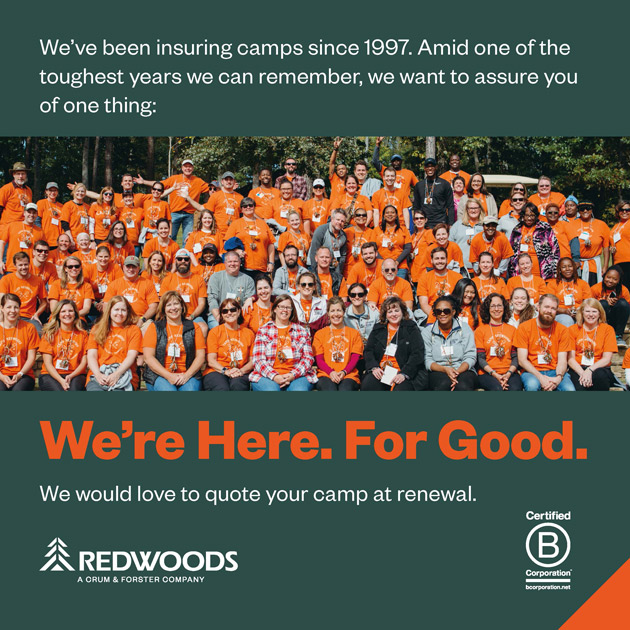More than 20 years ago, Bill Gates coined the phrase “content is king,” referring to the future of the internet. That’s never been truer than today in the social media realm. Creating good social content is critical to getting visitors to your website and campers in your cabins. A single, simple image can reach thousands of parents, alumni, and campers with just a click or tap.
Building that content is time-consuming, certainly, but not hard. There’s no magic formula to social media. Professional marketers use tried-and-true tactics to increase engagement and reach their audiences — and you can too.
1. Choose Your Best Channels
For reaching parents, Facebook and Instagram will be your dominant social media platforms. Teens are more likely to be on Instagram and Snapchat. You may also find Twitter to be of value in providing quick updates and participating in your local conversations. But you don’t have to be everywhere all the time. Don’t spread your staff too thin. Pick your top avenues and post regularly and consistently.
2. Create a Values-Based Strategy
Simply sharing program information isn’t enough. Camps need to talk about the values they hold in common with their camp families and communicate how camp can help kids achieve those values. Author Simon Sinek coined a popular maxim here: “People don’t buy what you do, they buy why you do it.” Kids want to go to camp for the fun, adventure, and exploration. Their parents will appreciate your organization’s timeless values of leadership, integrity, and character development.
3. Cultivate and Tell Excellent Stories
Consumers are drawn to good stories no matter the source. Telling stories builds passion and interest for the long term. Try to develop aspirational narratives that campers and their parents can imagine themselves at the center of. For many young campers, this may be the first time they have participated in a given activity. So tell stories about campers engaged in actual activities, such as:
- Paddling a kayak
- Leaping into the deep end of the pool
- Catching a fish
- Making a movie
- Building a water-balloon catapult
- Picking up a snake
- Shooting a bow and arrow
Repeat and reinforce these stories as much as possible across all your marketing channels — at promotional events, in media outreach, on social media, and in publications and advertisements.
4. Put Real Faces on the Camp Experience
Stock photography is instantly identifiable as such, especially to people who know your camp and its people. Media- and marketing-savvy parents crave authenticity and can tell when something is fake or staged. Your target audience is hungry for real people in real situations. Capture those stories and faces in interviews, videos, and photographs during the summer months, and use them to shape stories. (Make sure you have releases on file.)
5. Use a Calendar
It’s easy to come up with content ideas, but just as easy to become overwhelmed. A simple calendar can be a great planning tool, identifying when you have gaps in your schedule. I use a standard spreadsheet that lets me easily move items around, with entries color-coded to help me track what I’ve already written. If you’re starting from scratch, aim for regular content once a week at first, and then expand. Eventually, posting content daily or four to five days a week should be your goal. Your social media calendar should also be tied to your offline marketing efforts. Sync it with your direct mailings, e-blasts, advertising, text alerts, and promotional events.
6. Keep It up During the Summer
Some camps go dark on marketing during the summer. Because their staff is busy delivering programs, updating a Facebook page can quickly drop to the bottom of the priority list. But summer is the perfect time to showcase the program through social media and set the hook for future seasons. Investing just a few minutes a day can produce great results. Candid photos of handling frogs and bugs, close-ups of appetizing food, group shots of campers acting goofy — they’re simple but eye-catching methods to get parents thinking about what their children are missing out on.
7. Integrate Your Website
Families can’t register for camp on Instagram or Twitter, so most of your posts should provide a hook that catches readers’ attention and invites them back to your website. A good blog with regular posts and striking photos is an effective tool to drive visitors to your website. Just include enough of a teaser on social media to get people to click back. If you’re posting about a handful of slots left for your fourth summer session, then link to the registration page to make it as easy as possible for parents to sign up their children.
8. Feature Other Voices
Don’t just write from the perspective of an omnipotent camp director. Invite camp staff, alumni, campers, and parents to contribute and share their thoughts, feelings, and memories. If you have reluctant writers, giving them some questions to answer is a good way to start. Edit it into a post, or just put it up in a Q&A format.
9. Showcase Your Staff
Posting short staff profiles and photos will do two things. First, it will remind campers of one of the main reasons they keep coming back. Second, it will reassure parents that their children are in good hands. Just basic information is enough — their name, position, years at camp, where they go to school, favorite things to do, and a quick quote about camp will do the trick.
10. Use Video — The Simpler the Better
Good social videos don’t have to be slickly produced promotional efforts. In fact, they shouldn’t be. Authenticity is what drives viewers and fans. In my job working for a school district, I posted an 18-second clip of seniors walking down the football field for graduation practice. The sound and picture quality weren’t great because it was windy and loud, but it got 4,700 views within a few hours, a considerable number for the district’s size.
11. Go Behind the Scenes
Take your followers where campers don’t normally go:
- Into the kitchen as the crew prepares scrambled eggs
- Riding along with the ranger to repair a fence
- Walking with the staff during prep week as they set up tents or prepare cabins
- Standing next to the aquatics director during lifeguard training
Give viewers a bird’s eye view of the innerworkings of camp.
12. Highlight Your History
Unless you’re just starting a camp from scratch, you can conjure up memories and tap into good feelings of bygone days with photos and reminiscences from years past. The hashtag #throwbackthursday (or #tbt) is very popular on social media. It’s also a great way to identify active alumni and get them involved. Don’t overlook anniversaries!
13. Support Your Signups
Social posts are a great way to reinforce your marketing efforts. Make sure the imagery, slogans, and messages you’re using in your advertising, brochures, and emails are reflected on social media. And again, always link back to your website.
14. Tell Your Story in Different Ways
A photo plus a paragraph of text about what’s in the photo is the tried-and-true social media technique. But you can also create a first-person writeup, a longer-form FAQ, an infographic, a how-to video or article, or a top-10 list. These alternate methods can help catch readers’ attention and make your content shareable beyond just a single day.
15. Consider Contests
Raffles, quizzes, and giveaways can engage your community and spread the word quickly. Prizes don’t have to be huge. A branded water bottle, a pizza night for a camper’s cabin or the title of Camp Director for a Day are all inexpensive gestures that build substantial goodwill in the name of fun. Contests provide the benefit of increasing your engagement — comments, shares, and likes — which in turn boosts the number of people who see your posts. Just make sure to follow the specific rules of the social media platform that you’re on, or you’ll get dinged.
Resources
For more information on social media strategies you can use to promote your camp, visit:
• Social Media Today: covers social media news, with a good dose of how-to advice that will get you thinking. socialmediatoday.com
• The Content Marketing Institute: has some good resources and articles that can help stretch your mind and develop great local ideas that work for you; contentmarketinginstitute.com
• “Content Is King”: Read Bill Gates’s original essay. It has insights that are still applicable more than 20 years later; craigbailey.net/content-is-king-by-bill-gates/
• Seth Godin: A popular author whose short, pithy takes on marketing can spark ideas and inspiration for your social media channels; sethgodin.com
Dan Shortridge is a veteran communications professional based in Delaware. He serves as public information officer for a local school district and has led communications efforts at two state agencies. He is a volunteer with the Boy Scouts of America and spent the best time of his youth working on camp staff.




